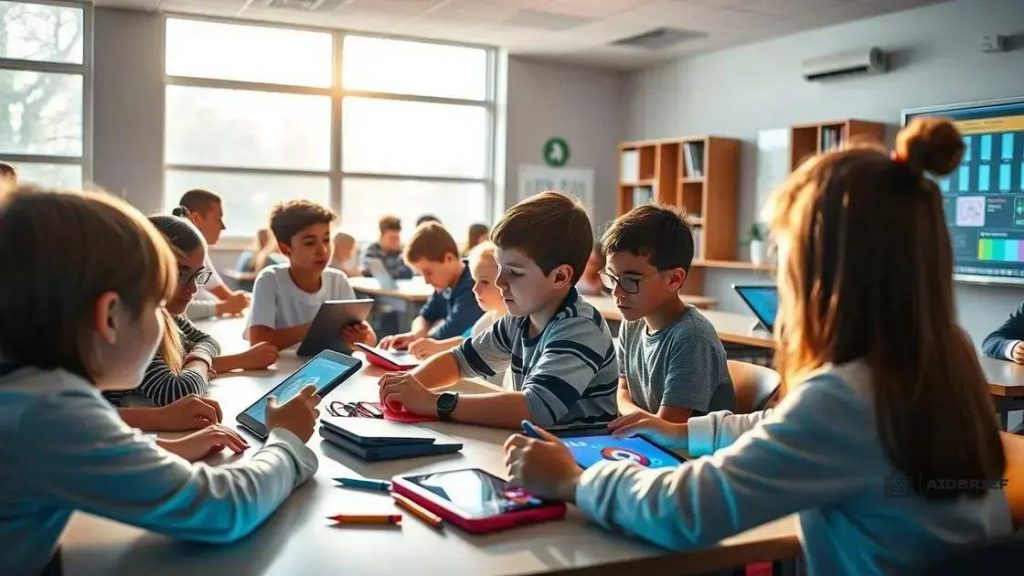Gamification in education: engaging digital native learners

Gamification in education enhances student engagement by integrating game elements like points and rewards, fostering collaboration and personalized learning experiences while addressing challenges such as resistance to change and technology access.
Gamification in education is transforming how educators connect with students, especially the digital natives. Have you ever wondered how games can make learning more fun and effective? Let’s dive into this fascinating approach!
Understanding gamification in educational context
Understanding the concept of gamification in education is crucial for engaging today’s digital native learners. By incorporating game-like elements into lessons, educators can create a more dynamic and interactive learning environment.
One key aspect of gamification is that it motivates students to participate more actively in their learning. When students see their tasks as challenges or games, they often feel more encouraged to complete them. Moreover, gamification can significantly enhance student engagement and retention of information.
Benefits of gamification in education
There are several notable benefits of applying gamification techniques in educational settings:
- Increased motivation to learn through fun activities.
- Enhanced collaborative skills as students work in teams.
- Immediate feedback provided on tasks and challenges.
- Personalized learning experiences tailored to individual needs.
By introducing gamification, teachers can tailor their instructions to fit the needs of various learners, ensuring that all students stay engaged. It’s not just about making lessons fun; it’s about creating a supportive atmosphere where students can thrive.
How gamification changes the learning experience
Gamification transforms the traditional classroom by shifting the focus from rote memorization to an interactive learning process. This shift encourages students to embrace a growth mindset, where challenges are viewed as opportunities rather than obstacles. For example, platforms that incorporate gamified elements often provide achievement badges or points, which can motivate students to strive for success.
Furthermore, it fosters a sense of community among peers, as they often collaborate on team-based challenges. This collaborative spirit is essential in preparing students for real-world scenarios, where teamwork is vital.
Benefits of gamification for student engagement
The benefits of gamification for student engagement are profound and wide-ranging. By incorporating game-like elements into the educational experience, schools can transform learning into a more enjoyable activity. This leads to higher levels of participation and enthusiasm among students.
Increased Motivation
One of the greatest advantages of gamification is that it greatly increases students’ motivation to learn. When children perceive educational tasks as games, they are more likely to engage with the material. This shift not only makes learning fun but also encourages creativity and risk-taking.
- Students often set personal goals to level up in their learning.
- Friendly competition can drive students to excel.
- Game mechanics can enhance focus and persistence.
- Students receive immediate feedback on their progress.
With these aspects in place, students feel a sense of achievement, which is essential for maintaining interest in their studies. They often become more invested in their lessons and eager to succeed.
Fostering Collaboration
Another significant benefit of gamification is its ability to foster collaboration among students. In a gamified learning environment, students frequently work together to solve problems or complete challenges. This collaborative effort develops essential social skills.
Effective teamwork prepares students for future workplaces, where collaboration is crucial. When students are encouraged to share ideas and work as a team, they experience a sense of community that enhances their overall learning experience.
Additionally, gamification offers opportunities for peer support, where students can help each other succeed. This not only enriches the learning process but also builds strong classroom relationships.
Overall, the integration of gamification in education leads to improved engagement, social interaction, and motivation. The combination of these factors creates a positive learning environment, where students thrive and become lifelong learners.
Strategies for implementing gamification in classrooms

Implementing gamification in classrooms requires thoughtful strategies to ensure success. Educators can enhance student learning experiences by integrating game elements effectively. These strategies encourage engagement, motivation, and a love for learning.
1. Set Clear Goals
Before introducing gamification, it is important to establish clear learning objectives. These goals should align with the curriculum while incorporating game mechanics. When students understand what they are working towards, they are more likely to stay engaged. Setting short-term milestones can create a sense of accomplishment.
2. Use Game Elements
Incorporating game elements such as points, badges, and leaderboards can motivate students. Points can be awarded for completing assignments, participating in class discussions, or collaborating with peers. Badges serve as a reward for achievements, while leaderboards create healthy competition among students.
- Points keep track of student progress.
- Badges celebrate individual accomplishments.
- Leaderboards foster friendly competition and motivation.
This combination not only makes learning fun but also provides students with feedback on their performance.
3. Create Interactive Challenges
Interactive challenges are central to gamification. Teachers can design group activities that encourage collaboration, problem-solving, and creativity. These activities should be structured as games, where students can work together to overcome challenges or solve puzzles.
For example, educators might organize a scavenger hunt where students find answers to questions hidden around the classroom. Such challenges promote teamwork and keep students engaged while learning important concepts.
4. Encourage Reflection
Reflection is an essential part of the learning process. After completing a gamified activity, students should take the time to discuss what they learned and how they felt about their experience. This can help reinforce knowledge and connect learning outcomes to real-life situations.
Through regular reflection, students can identify areas for improvement and celebrate their successes, which enhances their motivation to keep learning.
Challenges educators face with gamification
While gamification offers many exciting benefits in the classroom, educators also face several challenges in its implementation. Understanding these challenges is essential for creating effective learning environments that use gamification strategies.
1. Resistance to Change
One major challenge is the resistance to change among educators and students. Traditional teaching methods have been used for many years, making it difficult for some teachers to adopt new approaches. Students may also be hesitant to engage in a learning environment that differs from what they are accustomed to.
Overcoming this resistance often requires professional development and training for teachers. Schools need to provide support and resources to help educators understand the value of incorporating gamified elements.
2. Time Constraints
Another significant hurdle is the time constraints that teachers face. Designing and implementing gamification strategies requires careful planning and preparation, which can be challenging in a packed curriculum. Some educators may struggle to find the time to create engaging games or activities that meet educational standards.
- Lesson planning may take longer with gamification.
- Teachers have to balance gamification with required curriculum goals.
- Some may lack the resources to develop effective gamified experiences.
Time management skills and administrative support can be beneficial in addressing these constraints.
3. Equity and Access Issues
Equity and access present another barrier to effective gamification. Not all students have the same access to technology and resources. Some may lack personal devices or reliable internet connections, limiting their ability to participate in gamified learning experiences.
To overcome this challenge, schools must strive to provide equitable access to technology. This might involve providing devices for students or creating offline versions of gamified activities that do not rely on technology.
4. Assessing Learning Outcomes
Assessing student learning outcomes in a gamified environment can be more complicated than traditional methods. Educators need to develop effective ways to measure whether gamification is helping students achieve their learning goals. Standard assessments may not accurately reflect a student’s understanding or progress when learning through games.
This often requires teachers to create new assessment strategies that align with game-based learning. Using both formative assessments and reflective practices can help in understanding student progress.
Future trends in gamification and education
Future trends in gamification within education are exciting and full of potential. As technology evolves, so do the ways educators implement game-based strategies to enhance learning. Understanding these trends helps educators adapt their teaching methods to better meet the needs of students.
1. Personalized Learning Experiences
One growing trend is the use of personalized learning through gamification. Educators are beginning to tailor game elements to fit individual student needs. By analyzing performance data, teachers can create specific pathways that allow students to progress at their own pace.
Gamification will allow for more on-demand learning. As a result, students can focus on areas where they need the most growth while enjoying the benefits of game-like engagement.
2. Integration of Virtual and Augmented Reality
Virtual Reality (VR) and Augmented Reality (AR) are expected to play significant roles in the future of gamification. These technologies can create immersive environments where students can interact with educational content in a completely new way. For instance, students might explore ancient civilizations through VR while embarking on quests that reinforce learning objectives.
- AR can bring historical events to life in the classroom.
- VR can simulate real-world experiences for practical skill-building.
- Games will become more interactive, aiding in concept retention.
This technological integration will create rich learning experiences that motivate students to engage more deeply with the material.
3. Enhanced Data Analytics
As data analytics continue to improve, so will the ability to track student progress in gamified settings. Educators will leverage advanced analytics to assess how well gamification strategies are resonating with students. This information can inform adjustments to game mechanics, ensuring that they remain relevant and effective.
Data-driven insights will help tailor challenges to the interests and strengths of each student, further enhancing the learning process.
4. Collaboration and Community Building
Another future trend is the focus on collaboration and community building through gamification. Education systems will likely emphasize teamwork as students participate in cooperative games that require group collaboration to achieve goals. These activities can foster a sense of belonging and camaraderie among students.
As students work together to solve problems, they develop essential social skills alongside academic knowledge. This approach promotes an environment that values both individual achievement and collective success.
In conclusion, gamification in education is an exciting tool that offers numerous benefits for student engagement and learning. By embracing new technologies and strategies, educators can create dynamic learning environments that keep students motivated and involved. As we look to the future, trends such as personalized learning, virtual reality, and enhanced data analytics will further shape these experiences. While challenges remain, the potential for growth and improvement in education through gamification is immense, making it a vital part of modern teaching practices.
FAQ – Frequently Asked Questions about Gamification in Education
What is gamification in education?
Gamification in education refers to the use of game-like elements, such as points, badges, and challenges, to enhance student engagement and learning.
How does gamification increase student motivation?
By turning learning tasks into games, students are more likely to find them enjoyable and engaging, which boosts their motivation to participate.
What are some challenges educators face with gamification?
Challenges include resistance to change, time constraints for planning, equity in technology access, and assessing learning outcomes effectively.
What future trends can we expect in gamification and education?
Future trends include personalized learning experiences, integration of virtual and augmented reality, enhanced data analytics, and a focus on collaboration.





